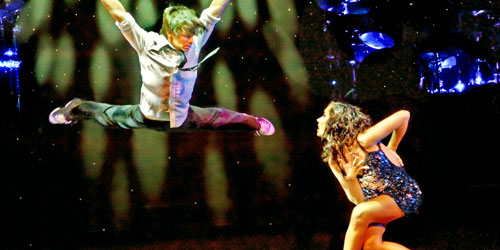By Michael H. Margolin

"Burn the Floor" continues at Detroit's Fisher Theatre through March 6. Photo: Beyton Erkman
"Burn the Floor" opened at the Fisher Theatre Feb. 22 and I am still exhausted from just watching the 20 young, fit, lithe dancers: They must burn up enough calories for a roomful of weight watchers at each performance – we do know from the "Fast Facts" sheet in the press kit that "90 liters of water are consumed backstage at every performance."
So, this show, which is loosely modeled on the traditional form of dance known as ballroom – as seen in the terrific Baz Luhrmann film of 1992, "Strictly Ballroom" – updates the dances such as the samba, foxtrot, waltz, jive, Lindy Hop, quickstep, into a high energy style I would call Brute Ballroom.
Now, hold on, that is NOT pejorative, just as the art movement labeled Brute Art is not. But the style, blended furiously and imaginatively out of the rigors of ballroom into a potpourri of high energy dance works, calls to mind the post modern dance that began, I think, with the Broadway show "Bring in 'Da Noise, Bring in 'Da Funk."
In that show, the brilliant Savion Glover took the traditions of tap, soft shoe and theatrical tap and embellished them, polished them to a hard edge, like razor blades and stilettos, and I don't mean heels. The influence of brute tap has gone far and wide in the commercial dance world.
Similarly, choreographer/director Jason Gilkison has found the hard edge in ballroom, then surpassed it: If it is jive, the dancers feet and legs are like pistons; if it is a samba, the bodies are stretched like rubber bands; if it is a foxtrot, the fox is furiously running from pursuing dogs. Unlike classical or even modern dance, almost all of the movement stays close to the floor as it does in ballroom – though there are a few lifts.
The music is mostly percussion under the driving arms and hands of Joseph Malone and Henry Soriano. They are upstage, on high platforms, commanding major assemblages of percussion, largely, it seems drums. (There are some recorded tracks of melodic music here and there.) It is big and boisterous and leaves no room for doubt that hot things are happening on stage. The floor is burning, metaphorically; to misquote the Elvis song: a hunka, hunka burning floor.
There is no doubt that only today's generation of dancers, raised on healthy foods and vitamins and trained on the heels of the modern dance movement and Broadway high flyers like Bob Fosse, could pull it off.
There are five featured dancers: Anya Garnis, Pasha Kovalev, Robbie Kmetoni, Janette Manrara and Karen Hauer, but the cast seems to be equal in talent and ability. Many of them will be familiar from their appearances on television shows such as "So You Think You Can Dance" and "Dancing With the Stars."
Backing them up are Vonzell Solomon, known as Baby V, a second runner-up in the fourth season of "American Idol." Her vocals are sultry and smooth ("Nights in White Satin" surpasses). Henry Soriano steps down from the upstage percussion to croon elegantly.
The first act is, strictly speaking, simply hyper ballroom. Section after section shows the dancers strutting their stuff. The sections end with the drop and catch, the guy being the muscle and the girl bent backward on his arm or curled onto his torso, then dropped to the floor for a brief pause, then blackout.
By Act II, some diversity is necessary and, voila, it is on. Brief, if flimsy, narratives are introduced here and there: two women compete, a couple of men enact bullfighters who seem a bit pissed with one another. At some point, a scrim descends and some dance occurs in an isolated band across the front of the stage. Colors and lights dim and explode: A twirling faceted ball up high sprays lights like rainfall over the stage. In both acts, dancers descend into the aisles for a moment or two.
Gilkison does not miss a trick, using all parts of the stage and the front of the auditorium. There are some dances performed without shoes, and there is an elegant waltz with the boy in black tie and the girl in a white gown that is lyrical and sweet: One wishes that it was a leitmotif occurring throughout the two acts, just to remind us of the recent past when lyricism was de rigueur. So, too, a bit of same-gender pairing could lighten the intense hetero atmosphere.
And finally, there is plenty of bareness in the attractive costumes by Janet Hine (based on John Van Gastel's original designs). She seems to have run out of buttons, so most men's shirts are open, baring their muscular torsos above pants low enough for a limbo dancer: Parents, no need to worry, there are no six packs to tempt the teens. These are dancers with long, stretched muscles rather than pumped up movie star bulges. Only one boy does not bare his midriff – either a scar or a really gross tattoo is my guess.
The women have long, elastic legs and slim upper bodies. The one exception is a quite wonderful dancer – Giselle Peacock, if I heard the name right when names were called out during the finale. She is short, by comparison with the others, and compact of build. She absolutely ate up the space around her, a dancing Rapunzel, spinning pure gold when she moved.
The show is for young teens as well as adults; it can easily be a family outing with no uncomfortable or challenging issues to worry over. If you missed Cirque de Soleil's "Dralion" last week, get thee to the Fisher for a pure entertainment experience.
REVIEW:
'Burn the Floor'
Fisher Theatre, 3011 W. Grand Blvd., Detroit. Tuesday-Sunday through March 6. $29-$69. 313-872-1000. http://www.broadwayindetroit.com










